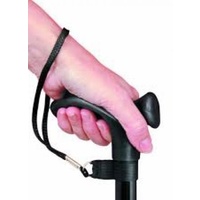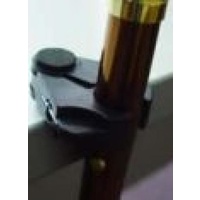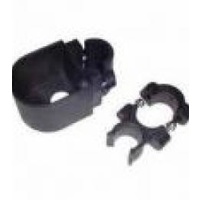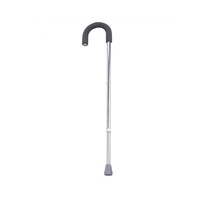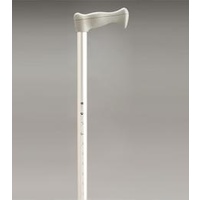Walking Stick Devon Handle
Aluminum adjustable height, single point, plastic moulded T-handled walking stick.
Description
A walking stick, also known as a cane, is a simple yet effective mobility aid that can provide numerous benefits for users.
Here are some of the key advantages:
Balance and Stability:
A walking stick helps to increase your base of support, improving your balance and stability when walking. This can be particularly beneficial on uneven terrain or when navigating steps or curbs.
Reduced Load on Lower Limb:
For individuals with an injury or chronic conditions such as arthritis, a walking stick can help to decrease the weight and pressure on the affected leg, providing pain relief and aiding in the healing process.
Confidence and Independence:
The extra stability provided by a walking stick can boost the user's confidence, facilitating greater independence and the ability to walk without assistance from others.
Energy Conservation:
By providing an additional point of support, a walking stick can help to conserve energy, making walking less exhausting for individuals with limited endurance or respiratory issues.
Injury Prevention:
For those with balance problems or weakness, a walking stick can help prevent falls, which are a leading cause of injury among older adults.
Gait Improvement:
A walking stick can assist in establishing a more regular and safe walking pattern, especially after an injury or surgery. It can help distribute weight more evenly and encourage proper gait mechanics.
Affordability and Accessibility:
Walking sticks are generally inexpensive compared to more elaborate walking aids, making them a more accessible option for many people. They are also widely available in a range of styles and materials.
Portability:
A walking stick is lightweight and easy to carry. Some models are foldable, which makes them convenient to transport and store when not in use.
Versatility:
They can be used in a variety of settings, both indoors and outdoors, and they are easy to maneuver in tight spaces where larger mobility aids might not fit.
Customizability:
Walking sticks come in various designs, colors, and materials, and can be customized with different handles and tips to match the user's needs, preferences, and style.
Functional Features:
Some walking sticks come with additional features such as built-in seats, lights, or even small storage compartments for added utility.
Rehabilitative Support:
For those recovering from injuries or surgeries, a walking stick can be part of the rehabilitation process, helping to gradually increase weight-bearing activities as strength and mobility improve.
It's important for a walking stick to be properly fitted to the user’s height and used on the correct side of the body to offer the best support. Improper use or the wrong size can actually increase the risk of falls or discomfort.
Additionally, the type of handle and tip can affect comfort and grip, so these should be chosen carefully to suit the individual's physical capabilities and the environments in which they will be walking.
Consulting with a healthcare professional can ensure the walking stick is used correctly and safely.
Specifications
- Plastic T-shaped handle
- Handle height: 79cm - 102cm ( 25mm increments )
- Approximate user height: 5'3" - 6' 1"
- Maximum user weight capacity: 114kg
| SKU | 15-0624 |



 Hire Mobility Equipment
Hire Mobility Equipment



